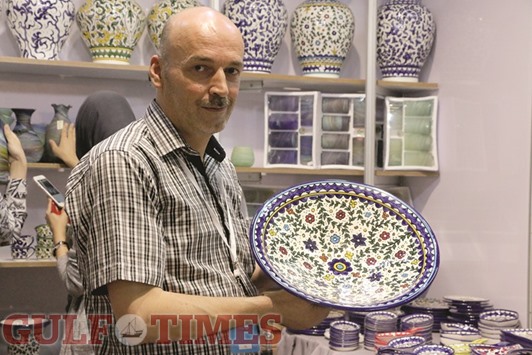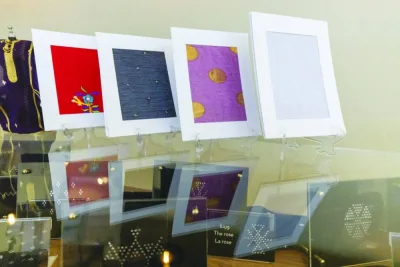Situated at a crossroads of continents and civilisations, accommodating a number of peoples and empires since the old times, the art and artisan work of Palestine depicts an infusion of multiple cultural influences while maintaining its own individuality.
Bringing a piece of this rich cultural heritage, men and women artisans from different areas of Palestine have come to town to showcase the rich and colourful Palestinian heritage through traditional clothes, food and arts.
Offering an opportunity to people to better understand and appreciate the social and historical backgrounds of the Palestinian customs and heritage that varies from one region to the other, the 2nd Palestinian Heritage Festival at Katara Cultural Village Foundation, organised in co-operation with the Palestinian National Friendship Association, brings together art that is unique to this historical land.
From the centuries-old art of pottery-making to the more contemporary art of Silver Olive Leaf jewellery, the festival presents artefacts that are unique to the area. Traditional Palestinian music plays in the background as you walk through the bazaar set up in Building 2 of Katara Cultural Village, with colourful olive wood-carved designs and shiny ceramics lined up on both sides.
“Olive wood is a blessed heritage of Palestine. With my hands, I carve on it the history of Palestine through its religious places, buildings and monuments. These designs of buildings, animals, maps, and other artefacts, are all handmade,” Yasar Barham tells Community.
Coming from Bethlehem, he says these art works are very popular with visitors coming to Palestine. However, the security situation in his country, he says, has destroyed the tourism industry and they hardly get any foreign tourists these days. “We find it hard to find buyers for these items back home. We are only hoping that the situation gets better. We have come here with the hope to sell as much as possible and the response so far has been mixed,” he adds. He has taken his artwork outside Palestine to many countries including Turkey where he says it sold really well.
He makes everything with his own hands and this art has been in his family for generations where artisans in Bethlehem have carved olive-wood and mother-of-pearl into relics and souvenirs for the locals and the pilgrims. One of the most astounding contemporary form of art is Silver Olive Leaf jewellery brought to the festival by Nadia Abu Ghattas. She casts silver on olive leaf and turns them into bracelets, necklaces, rings, and other jewellery items for women.
“Women are crazy after this type of jewellery because it is very unique. I make it all with hands. I pluck the leaves, clean them, solder them and make sure they are ready for the silver casting. It takes time but the result is something really beautiful,” says Nadia.
She has kept the price of the jewellery items not very high as she intends to popularise this form of art to make it a signature art from Palestine. People, she says, can identify it as Palestinian art just as they can identify jewellery from India and other parts of the world.
“It takes me a lot to go to the olive trees and sift through the leaves to find the ones with smooth surface that can be used for jewellery-making. The leaves with rough or broken edges cannot be used and as you know they are small, it takes a lot of time to select the right one,” says Nadia.
Coming from Bethlehem, she says they get a lot of tourists because of the Nativity Church but for the past few months, she also acknowledges the city has suffered in tourism due to security situation. She has been making this kind of jewellery for over five years now.
Ziad Natsheh from Hebron has brought to the festival his family’s centuries-old art of ceramics and glow-blown handmade designs. Depicting the traditional Palestinian designs in the signature blue colour, the ceramics instantly attract attention of the passersby with their glare. “This glass is all handmade. This art has been in my family for more than 400 years now. For the last few decades, we have also been making these glass items,” says Natsheh.
Some of the items are very expensive while others are more everyday use and are priced from a few dozen riyals to just over 100 Qatari riyals. Natsheh has gone all over the world with his artworks. He says these ceramics are particularly popular in Europe and South Africa which he has visited multiple times.

FROM THE HOLY LAND: Ziad Natsheh with his collection of blue pottery, unique to Palestinian heritage. Photo by Umer Nangiana


